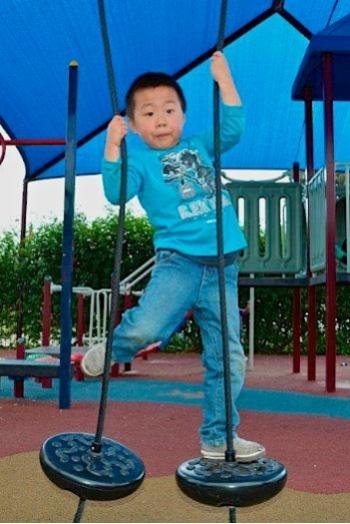Let's get physical
Duration/age

Most children find it fun to play - seeking out adventures and actively exploring the world with their bodies.
Playing at a park or a playground will give your child an opportunity to use all their big muscles and experiment with how to move their bodies in different directions. They can run as fast as the wind or roll down the hills like a spinning top.
There are other ways that you can encourage your child to be physical and active. You could try:
- unstructured free play like dancing or setting up a sandpit for digging
- structured planned play like games, songs or sporting activities
- going places on foot by walking to the shop or to kindy
- physical tasks like sweeping, helping in the garden or carrying the shopping in from the car
Materials you will need
- Your body
- Open space
Alternative tools
- Balls
- The dog
- A friend
- Frisbee
- Rope
Skills this activity improves
Why does this matter?
Regular physical activity when your child is very young can have a positive impact on their immediate and long term health.
Physical activity helps children to develop their senses, posture, strength and balance. As they move about they are using all of their body. Whole body movement will include their upper body, lower body and will help with trunk stability.
As they move around in the natural environment or use the playground equipment they are developing language to communicate what they are doing. They are exploring how their bodies move in and through space.
What does this lead to?
Encouraging your child to move in different ways helps them to understand that they can use and move their bodies in many ways. As they explore the different ways their bodies move they are learning about measurement, space and size and how to move within and around objects.
As your child moves they’re using all of their body and senses. They are developing strength, control and coordination in all of their body parts including the large muscles in their trunk. Having a strong core, or trunk, is important as it helps children with good sitting posture.
Language to use
- Body, movement, physical activity, spatial awareness
- Hop, jump, roll, slide, swing, climb, hide, skip
- Throw, catch, balance
- Through, over, under, around
- Forwards, backwards, sideways, downwards, upwards
- Ball, hoop, rope, climbing equipment, circuit
- Park, playground, dog park, reserve
Questions to use
- How fast can you run to the back fence?
- How many different parts of your body can you use to move the ball?
- Can you jump over the stick with your feet together?
- If you stand behind the tree can I still see you?
- Can you climb up all trees?
- Can you balance on the top of the fence?
- Can you move in a line that is straight, curved or diagonal?
Useful tips
- You might also like to take a look at the activities Playing with balls and Baby obstacle course.
- See 51 things to do before you're 12 for more ideas about being active and physical outside.
- For more information on your child's physical development see the Child Health Record - the Blue Book.
- The Department of Health also has some hints and tips about physical activity for children aged 0 to 5.
- Remember to talk to your child in your home language.
More ideas
- Make a map of all the different playgrounds and parks in your area. See if you can visit a different one each week.
- Make a ’be active’ kit that you keep in the car ready for a visit to the park.
- Create a family fitness challenge. How many steps, jumps, rolls or hops can each person do?
Variation by age
Birth to two year olds
- Sing songs that get your child to use different parts of their body.
- Borrow books from the library about different body parts and how to move your body.
- Hang balls in stockings from the clothesline. Try hitting the ball with your hand or head.
- Help your child to jump on the trampoline, swing on the swing or crawl through a box tunnel.
Three to five year olds
- Encourage your child to make up their own games and activities.
- See how many different positions you can place your body when you throw a ball.
- Play Twister or Simon Says.
- Sing songs that get your child to use different parts of their body.
- Make your own obstacle course from found objects.
Questions to ask
- What part of your body do you kick with?
- Can you catch the ball with your nose?
- How many jumps can you do?
Questions to ask
- Can you stretch up high or curl up small?
- Can you throw the ball while kneeling?
Language to use
- Head, shoulders, knees, hands, fingers, toes, legs, back
- Standing, sitting, kneeling, crouching, lying down, crawling, swinging
- Lots, little, few
Language to use
- Standing, sitting, kneeling, crouching, lying down
- Tall, short, little, big, small, long, wide
- Head, shoulders, knees, hands, fingers, toes, legs, back


